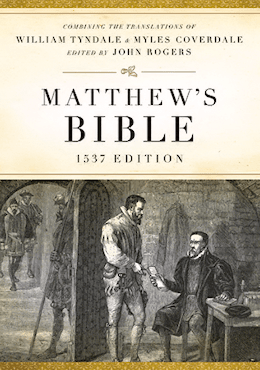Textus Receptus Bibles
Matthew's Bible 1537
| 26:1 | Like as snow is not mete in sommer, nor raine in haruest: euen so is worship vnsemelye for a foole |
| 26:2 | Like as the bryd and the swalowe take their flyght and fle here and ther, so the curse that is geuen in vayne, shall not lighte vpon a man. |
| 26:3 | Vnto the horse belongeth a whyppe, to the Asse a brydle, and a rodde to the fooles backe. |
| 26:4 | Geue not the foole an answere after hys folyshnesse, lest thou become lyke vnto hym: |
| 26:5 | but make the fole an answer to his folishnes, lest he be wise in his own conceat. |
| 26:6 | He is lame of his fete yea dronken is he in vanite, that committeth any thing to a fole. |
| 26:7 | Like as it is an vnsemely thing to haue legs & yet to halt euen so is a parable in the foles mouthe. |
| 26:8 | He that setteth a foole in hye dignity, that is euen as if a man did cast a precious stone vp on the gallous. |
| 26:9 | A parable in a fooles mouth is lyke a thorne that prycketh a dronken man in the hand. |
| 26:10 | A man of experience dyscerneth all thynges well, but whoso hyreth a foole, hyreth such one as will take no hede. |
| 26:11 | Lyke as the dogge turueth agayne to hys vomyte, euen so a foole beginneth hys folishnesse agayne a fresh. |
| 26:12 | If thou seiest a man that is wyse in his owne conceate, there is more hope in a fole then in him. |
| 26:13 | The slouthful sayeth: there is a leopard in the way, and a lion in the myddest of the stretes. |
| 26:14 | Lyke as the dore turneth aboute vpon the thresholde, euen so doth the slouthfull welter hym self in his bedde. |
| 26:15 | The slouthful bodye thrusteth his hand into his bosome, and it greueth him to put it agayne to his mouth. |
| 26:16 | The slogard thynketh hym selfe wyser then? .vij. men that sit & teach. |
| 26:17 | Who so goeth by & medleth wyth other mens stryfe, he is lyke one that taketh a dog by the eares. |
| 26:18 | Lyke os one shutteth deadly arowes and dartes out of a preuy place, euen so doth a dissembler wyth his neighboure. |
| 26:19 | And then saith he: I dyd it but in sporte. |
| 26:20 | Where no wodde is, there the fyre goeth oute: and where the backcbyter is taken awaye, there the stryfe ceaseth. |
| 26:21 | Coales kyndle heate, and wode the fire: euen so doth a braulynge felowe stere vp varyaunce. |
| 26:22 | A slaunderers wordes are lyke flaterye, but they pearse the inwarde partes of the bodye. |
| 26:23 | Venimous lippes and a wicked herte, are lyke a potsherde couered with syluer drosse. |
| 26:24 | An enemy dissembleth with hys lyps, and in the meane season he ymagineth mischefe: |
| 26:25 | but when he speaketh fayre, beleue hym not, for ther are seuen abhomynacons in hys herte. |
| 26:26 | Who so kepeth euel wil, secretly to do hurte, his malice shalbe shewed before the whole congregacion. |
| 26:27 | Who diggeth vp a pyt, shal fal therin: and he that weltreth a stone shal stomble vpon it him selfe. |
| 26:28 | A dissembling tong hateth one that rebuketh hym, and a flattering mouth worketh mischefe. |

Matthew's Bible 1537
The Matthew Bible, also known as Matthew's Version, was first published in 1537 by John Rogers, under the pseudonym "Thomas Matthew". It combined the New Testament of William Tyndale, and as much of the Old Testament as he had been able to translate before being captured and put to death, with the translations of Myles Coverdale as to the balance of the Old Testament and the Apocrypha, except the Apocryphal Prayer of Manasses. It is thus a vital link in the main sequence of English Bible translations.